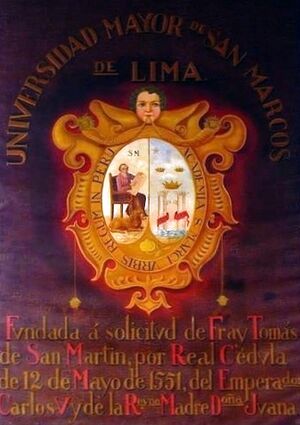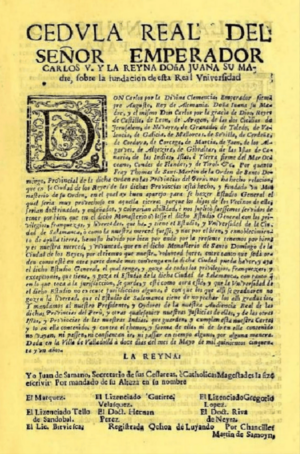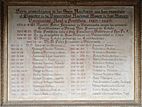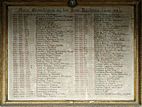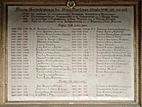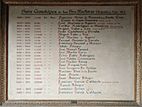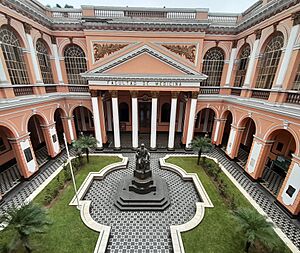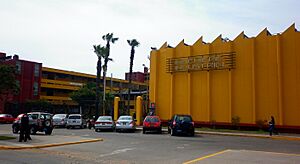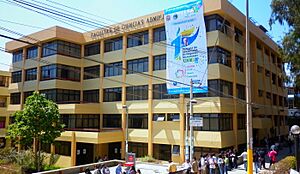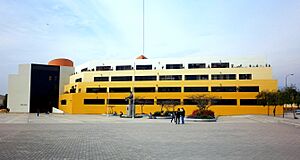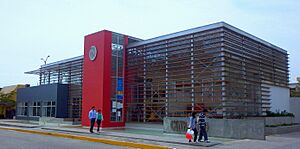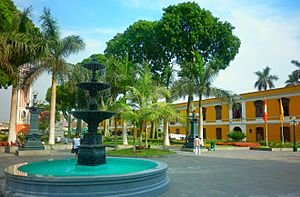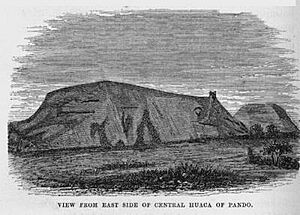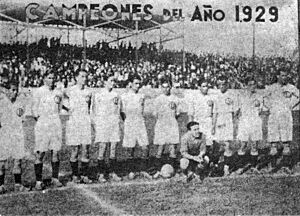National University of San Marcos facts for kids
|
Universidad Nacional Mayor de San Marcos
|
|
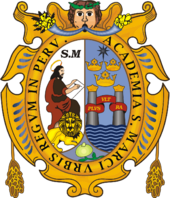
Coat of arms
|
|
| Latin: Academia S. Marci Vrbis Regvm in Perv | |
|
Former name
|
Royal and Pontifical University of the City of the Kings of Lima, University of Lima |
|---|---|
| Motto | Universidad del Perú, Decana de América |
|
Motto in English
|
University of Peru, Dean of the Americas |
| Type | Public university |
| Established | May 12, 1551 (474 years ago) |
| Founder | Charles I of Spain |
| Affiliation | National Association of Public Universities of Peru, International Association of Universities, Iberoamerican Association of Postgraduate Universities, Organización Universitaria Interamericana, Association of Universities of Latin America and the Caribbean, Universia, Fudan-Latin America University Consortium |
| Endowment | S/.469,000,000 (FY 2013) |
| Rector | Jeri Ramón Ruffner |
|
Academic staff
|
3,315 (2017) |
| Students | 37,468 (2020) |
| Undergraduates | 30,866 |
| Postgraduates | 6,602 |
| Location |
Lima
,
Peru
12°03′30″S 77°05′00″W / 12.05833°S 77.08333°W |
| Campus | Urban, 170 acres (69 ha) |
| Colors | Gold White Metallic blue Magenta |
| Mascot | Lion |
 |
|
The National University of San Marcos (known as UNMSM) is a public university in Lima, the capital of Peru. It is the very first university officially started in the Americas. It is also the oldest university that has been open and teaching continuously since it began.
The university began around 1548, offering general studies in a convent. It was officially founded on May 12, 1551, by a special order from Emperor Charles I of Spain. Later, in 1571, it received a special blessing from Pope Pius V, which led to its full name: "Royal and Pontifical University of the City of the Kings of Lima." People also called it the "University of Lima."
Over its long history, the university has had different schools. These included colleges focused on law, letters, medicine, and surgery. One of its most famous buildings is the "Casona de San Marcos" in the Historic Centre of Lima. This building is so important that UNESCO recognized it as a World Heritage Site in 1988.
Today, the University of San Marcos has 66 different study programs, grouped into 20 faculties and 5 main academic areas. It keeps many old documents and writings in its historical archive. In 2019, some of its oldest documents (from 1551 to 1852) were added to the UNESCO Memory of the World Register.
The National University of San Marcos is a leader in scientific research in Peru. It has often been ranked as the top university in the country. It is one of only three Peruvian universities, and the only public one, to reach this top spot. Many important people have studied or taught here, including twenty-one Presidents of Peru and the only Peruvian Nobel Prize winner. Because of its long history and excellent academics, it is seen as the most important university in Peru.
Contents
History of the University
How it All Began
The idea for the university started around 1548 in a convent in Lima. Fray Thomas de San Martín and Captain Juan Jerónimo de Aliaga traveled to Spain. They got a special order from King Charles I of Spain and Queen Joanna of Castile to create the university. It officially opened on January 2, 1553.
Later, in 1574, the university was officially named "Royal and Pontifical University of San Marcos." It was named after Mark the Evangelist, who became the university's patron saint. The university moved locations a few times in its early years.
From the 1700s to the 1900s
The University of San Marcos became part of the new Republic of Peru after its independence in 1821. The very first Congress of Peru was led by Toribio Rodríguez de Mendoza, who used to be the head of the University of San Marcos. Many of the people in that Congress had studied at San Marcos.
In 1822, the university gave its large collection of 50,000 books to start the National Library of Peru. In the 1870s, the university moved to its current main historic building, the Casona of San Marcos. During the War of the Pacific, some art and cultural items were taken from the university. After the war, a law in 1901 confirmed that San Marcos was the main university in Peru.
Modern Times
In the early 1900s, students at San Marcos pushed for changes in the university. They protested against unfair governments and asked for better classes and less government control. These efforts led to important reforms and more freedom for the university.
In 1946, the university's name officially became the National University of San Marcos. In 1951, to celebrate its 400th birthday, the university got new land to build its main campus, called the University City. The University Stadium was opened that same year. During the celebration, university leaders from across the Americas gave San Marcos the special title "Dean of America." This is why it is also known as the University of Peru and the Dean of the Americas.
In 1958, Vice President Richard Nixon of the United States planned to give a speech at the university. However, students protested against US policies, and the speech had to be moved. In the mid-1960s, many of the university's departments moved to the new University City campus.
In 2010, Mario Vargas Llosa, a former student of San Marcos, won the Nobel Prize in Literature. The university honored him with its highest award in 2011. In 2019, the university even awarded a special doctoral degree for a thesis written entirely in Quechua, an indigenous language.
University Symbols
The university has had different symbols over time. Its first official shield, used until 1574, showed the Virgin of the Rosary, the Pacific Ocean, and a lime fruit (referring to Lima). After 1570, the shield changed to feature Saint Mark and his symbol, the Lion, as the new patron saint.
The colors for the shield were officially set in 1929: blue for the ocean, black or brown for the saint, light blue for the background, and silver for the columns. The shield with Saint Mark and the Lion has been the university's symbol for the longest time.
Flag
The university's flag is white with the university's shield in the center. This design has been used for a long time and was officially adopted on June 14, 2010.
Anthem
| Adelante San Marcos glorioso adelante tú siempre estarás, porque nadie ha podido vencerte y jamás nadie te vencerá. (bis) |
| Es tu nombre un timbre de orgullo Tradición de nobleza y de honor, Siempre grande, siempre limpia tu bandera muy alto estará. |
| Sanmarquinos unidos por siempre en tan grande y profunda misión, levantemos muy alto la frente Convencidos de nuestro valor. |
The university anthem is sung at special events and anniversaries. The words were written by Manuel Tarazona Camacho, and the music by Luis Craff Zevallos.
Other important symbols include the Royal Certificate from 1551 that allowed the university to be founded, and an ancient Quipu (a knot-based record-keeping device) found at the Huaca San Marcos archaeological site.
How the University Works
Leadership and Management
The University of San Marcos is led by a Rector, who is like the president of the university. There are also two Vice-Rectors who help manage the academic programs and research. The university has had 216 Rectors since it was founded.
Important decisions are made by the University Assembly and the University Council. These groups include the Rector, Vice-Rectors, deans of the different faculties, and representatives from teachers and students.
Departments and Study Areas
The University of San Marcos has 20 faculties, which are like different departments or colleges. These are grouped into 5 main academic areas. They offer 65 different undergraduate programs, 77 master's degrees, and 27 doctoral degrees.
Health Sciences
The Faculty of Medicine "San Fernando" is a very important part of the university. It was created in 1856 and has often been ranked first in national medical exams in Peru.
Other health-related faculties include Pharmacy and Biochemistry (started in 1931), Dentistry (created in 1920), Veterinary Medicine (which became a faculty in 1946), and Psychology (created in 1963).
Basic Sciences
The Faculty of Chemistry and Chemical Engineering started in 1855. It added chemical engineering studies in 1964.
Other basic science faculties are Biological Sciences (became independent in 1866), Physical Sciences (started in 1966), and Mathematical Sciences (began in 1850).
Engineering
The engineering faculties include Metallurgical Engineering (1971), Mining Engineering (1980), and Geographic Engineering (1980). These later joined to form the Faculty of Geological, Mining, Metallurgical and Geographic Engineering. Civil Engineering and Environmental Engineering were added later.
The Faculty of Industrial Engineering was established in 1969. The Faculty of Electronic and Electrical Engineering grew out of courses from the Physical Sciences department. The Faculty of Systems Engineering and Informatics was created in 2000, building on earlier computer science programs.
Economics and Management Sciences
The Faculty of Administrative Sciences, Faculty of Accounting Sciences, and Faculty of Economic Sciences all started from earlier studies in political and administrative sciences. The Faculty of Administrative Sciences became its own independent faculty in 1984.
Humanities, and Legal and Social Sciences
The Faculty of Letters and Human Sciences has a long history, starting from the university's earliest days. It is now located in the University City and includes research institutes and cultural centers like the Museum of Art.
The Faculty of Education began in 1876 and became a full faculty in 1946. It is mostly located in the University City. The Faculty of Law and Political Science has roots going back to 1770. It also offers free legal help. The Faculty of Social Sciences was created in 1984 and manages the university's Museum of Archeology and Anthropology.
Studying at San Marcos
How to Get In
To study at San Marcos for an undergraduate degree, students usually need to pass an entrance exam. There are also special exams for students transferring from other universities, international students, top high school students, and students with disabilities. The main entrance exam is given twice a year, in March and September.
For postgraduate studies (like master's or doctoral degrees), admission is also competitive. An admission exam is given for these programs. In 2020, because of the COVID-19 pandemic, the university held its first-ever online admission exam.
International Programs
The University of San Marcos works with universities around the world. It has programs that allow students to study abroad and helps with research projects with international partners. It is also part of a group called the Strategic Alliance of Peruvian Universities, which helps students from different Peruvian universities exchange and study together.
University Rankings
| University rankings | |
|---|---|
| Global – Overall | |
| QS World | 901–950 (2025) |
| THE World | 1501+ (2023) |
| USNWR Global | =1778 (2024) |
The National University of San Marcos has a strong reputation. In 2006, it was ranked as the best university in Peru by the National Assembly of Rectors. It is one of only three Peruvian universities, and the only public one, that has reached the top spot in major international university rankings.
In 2021, the Webometrics Ranking of World Universities named San Marcos the best university in Peru. In 2022, it was recognized for having the highest number of scientific publications in Scopus, a large database of research articles.
University Campuses
Since it was founded, the University of San Marcos has been in several different places. Its first location was in a Dominican convent. Later, it moved to other spots in Lima, including where the Congress of Peru is today.
In the late 1800s, it moved to the historic Casona of San Marcos. Since the mid-1960s, its main campus has been the University City. This large campus is where the main administration building, the Central Library, and 17 of the 20 faculties are located. It also has the ancient archaeological site of Huaca San Marcos.
University City
The University City is the main campus of the National University of San Marcos. It is home to most of the university's departments, the main library, the University Stadium, and student housing. The campus also includes the important archaeological site of Huaca San Marcos.
The "Pedro Zulen" Central Library is a very large building with lots of space for studying and events. It helps to digitize publications and connects all the libraries in the different faculties. Each faculty also has its own library.
University Stadium
The Stadium of the National University of San Marcos, also called the "Colossus of America," is located in the center of the University City. It was opened in 1951 to celebrate the university's 400th anniversary.
The stadium was originally very large, holding 70,000 people. It was later updated to hold 32,000 people for events like the 2019 Pan American Games and the 2019 South American U-17 Championship. It used to be the home stadium for the university's soccer team, Club Deportivo Universidad San Marcos.
Research at San Marcos
The University of San Marcos has 37 research units and about 500 research groups. These groups work on studies in health, basic sciences, engineering, economics, and humanities. They have museums and laboratories and publish their findings. Since 2015, the university also has the Center for Technological, Biomedical and Environmental Research (CITBM).
Scientific Publications
The University of San Marcos is a major contributor to scientific research in Peru. In 2009, it produced 20% of all Peruvian scientific work. Some of its research has even appeared in famous science journals like Nature and Science. The university publishes its own academic journals for each faculty.
University Press
The university has its own publishing house, called the Editorial Fund. It publishes books, magazines, and newspapers, both in print and online.
Culture and Heritage
Cultural Centers
The National University of San Marcos has two cultural centers in its historic buildings: the Casona de San Marcos and the Colegio Real de San Marcos.
The Cultural Center "La Casona" of San Marcos is a popular place to visit in the Historic Centre of Lima. It is part of the area recognized as a World Heritage Site by UNESCO. It hosts many cultural and artistic events.
The Royal College Cultural Center of Contemporary Peruvian Cultures opened in 2006. It is located next to the Congress of the Republic of Peru. It includes the university's historical archive and hosts exhibitions. This building has a long history, dating back to 1592.
University Museums
The University of San Marcos has several museums. These include the Museum of Natural History of Lima, the Sacaco Paleontological Museum, the Museum of Art, the Museum of Archaeology, and the Historical Museum of Physical Sciences.
Archaeological Sites
The National University of San Marcos studies various archaeological sites, including the Huaca de San Marcos, which is on its campus. Many ancient items like ceramics, spondylus shells, and quipus have been found there. The Ministry of Culture of Peru has declared the Huaca San Marcos and other sites on campus as Cultural Heritage of the Nation.
Famous People from San Marcos
People who have been part of the National University of San Marcos, whether as students or professors, are often called sanmarquinos. This term is commonly used in Peru to refer to important figures from the university.
Sports at San Marcos
Students from San Marcos helped create the University Sports Federation of Peru in 1924. This federation organizes national and regional university sports games. The university has also participated in international university sports events.
The University of San Marcos has had professional football (soccer) teams. The most famous is Club Universitario de Deportes, which was founded by San Marcos students in 1924. Another team, Deportivo Universidad San Marcos, played in the second division until 2011.
The first university games were held in Lima in 1936. The University Stadium was opened in 1951. For the 2019 Pan American Games, the stadium was renovated and hosted the football events. It also hosted the 2019 South American U-17 Championship.
How Club Universitario de Deportes Started
On August 7, 1924, university students met to form a football club. This club, originally called Federación Universitaria, was recognized by the National Sports Committee. It joined the Peruvian Football Federation and started playing in the First Division Tournament in 1928.
In 1929, the Federación Universitaria team won the championship. After the first FIFA World Cup in 1930, the club traveled to play other teams. In 1931, the university's head (rector) asked them to change their name, and so they became Club Universitario de Deportes.
Club Deportivo San Marcos
In 2001, the University of San Marcos created a new football club called Club Deportivo Universidad Nacional Mayor de San Marcos. This team, nicknamed "The Lions" (because the lion is the symbol of Saint Mark), played at the San Marcos stadium until 2011.
See also
 In Spanish: Universidad Nacional Mayor de San Marcos para niños
In Spanish: Universidad Nacional Mayor de San Marcos para niños
- Education in Peru
- List of universities in Peru
- List of colonial universities in Latin America
- Casona de la Universidad Nacional Mayor de San Marcos
- University City of the National University of San Marcos
- National School of Sciences and Arts of Cuzco, considered the oldest school in Peru


